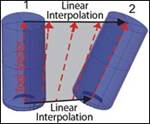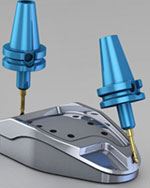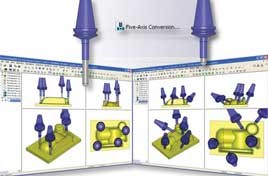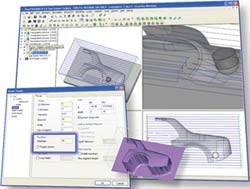Making the Most of High-Speed Machining
High-speed machining can cut mold manufacturing time in half, but only if it’s executed with an eye to the special needs of the tools and the process.
Thanks to advances in cutters (CNC control), milling machines and application software, high-speed machining has become a reality—and a significant aid to success—for companies that specialize in mold manufacture, prototype manufacture and other precision machining applications.
High-speed machining (HSM) technology is helping moldmakers increase productivity and decrease costs. The right software maximizes the benefits of the high-speed hardware, protects it from damage, minimizes wear and tear, and simplifies the programming of toolpaths, so that even infrequent users can be productive. It also can help a company bring new products to market—or refurbish heavy manufacturing products—faster than competitors, and so capture markets that need those qualities.
High-Speed Machining: Challenges and Solutions
Success with high-speed machining requires a thorough under-standing of the required tools and methods and of their benefits and limitations.
Speeds, Feeds and Tools of High-Speed Machining
High-speed machining features spindle speeds of 10K to 40K rpm, feedrates of up to 150 to 400 inches per minute, with relatively small depths-of-cut. It is most often used for applications that demand significant material removal or that require extremely hard metals. Applications range from automotive molds, dies, press tools and other large steel components to hard-metal machining, custom prototype parts, specialized medical products, such as hip and knee joints, and R&D projects with unusual materials.
Because of the extreme speeds involved in high-speed machining, the technique places unique demands on every piece of hardware that’s used in the process. Milling machines, cutters, holders and other components must be designed to maximize stability and minimize vibration, since excessive vibration can damage surface finish, reduce the life of the cutter and other tools, and even ruin tools or jobs.
CNC machines are built for maximum rigidity and cast rate. Cutters are made from solid, sub-micro grain carbide for maximum strength and to tolerate heat expansion of the holders. Cutter holders employ shrink-fit technology to maximize balance and minimize air friction. For the control systems that translate the software commands into actions, digital drives and direct measuring systems are required to produce the highest possible precision, and most accurate repeatability.
Characteristics of HSM Software
It is up to the high-speed machining software to make the most of these components, and to drive the process for maximum benefit. To do this, the software should excel in four areas: (1) optimizing tooling stability, (2) promoting toolpath efficiency, (3) maximizing operating performance and (3) enhancing ease of use—both in programming and operations.
1. Tooling Stability
High-speed machining is often classified as high-shock machining, and for good reason. Because of its high speed, the cutter is particularly vulnerable to the shock of impact every time it sets down on a new surface. The software should therefore minimize or soften cutter impact wherever possible. For roughing, the software should drive the cutter in a spiral helix rather than a direct vertical plunge when cutting deeply or it should ramp the cutter according to the surface profile. It should carefully control cutter motion into corners, and should not permit short on-off moves in corners. It should drive the CNC machine to maintain constant weight on moving spindle heads and tooling. And it should know the complete topology of the cutting tool, to avoid accidental contact, say, between the side of the cutter and the wall of the die, something that can cause vibration.
2. Toolpath Efficiency
The software’s ability to optimize toolpath design plays an important role in making high-speed machining effective.
For instance, the toolpath should be designed to get the maximum cutting from the largest possible tool in order to keep time and tool changes to a minimum. The toolpath design also should optimize toolpath routes to keep the cutter in contact with the material as much as possible. Minimizing fresh air cutting helps maximize the contact time of the cutter, and reduces cutter or insert wear by keeping cutter impact to a minimum. There are numerous other ways, some of which are extremely subtle, that the software does its job. One final example: when the tool does have to move from one surface to another at a sharp angle, the software should create a curved trajectory, in the air, rather than require an abrupt stop and start, in order to keep feedrates constant.
3. Operating Performance
High-speed machining creates a performance burden on the software itself, thanks to the high-speed data feeds as well as the various toolpath algorithms. To support powerful look ahead algorithms that can anticipate tool movements and changes, and to maintain ample headroom for handling large, complex projects, the underlying software architecture must be as efficient as possible. The software should support multi-threading and parallel processing. And it should employ effective compression techniques to keep internal file sizes to a minimum.
4. Ease of Use
High-speed machining software should promote ease of use in the conventional sense, offering contextual menus and consistent workflows, and keeping training time short. But it also should make it easy for the user to program the toolpath quickly and—important for lights-out machining—with confidence that the software will perform exactly as commanded.
Allowing users to define tools from spreadsheets or other external files is one way to simplify programming; another is to employ intelligent defaults that automate the more sophisticated aspects of the cutting—accelerating and decelerating as the cutter goes into corners, for instance. And yet another is to let the programmer create stock models to show what the mold will look like at any point in the process, in order to make any adjustments that might be required during the roughing and finishing stages. Finally, the reliability and precision of the toolpaths themselves should permit the machine operator to let the machine operate in lights-out fashion—overnight and without an attendant.
Summary
The drive in the manufacturing industry to reduce time-to-market and compress the product development process has pushed high-speed machining to mainstream production. Machine tools, CNC control and tooling are the foundation of a successful high-speed machining process, but choosing software that gives NC programmers confidence to leverage higher spindle speeds and feedrates, while minimizing the effect of vibration and maximizing tool life, is just as important. Software that offers extensive capabilities for efficient machining by providing CNC machines with optimized toolpaths will help moldmakers realize all the benefits of high-speed machining.
Related Content
Five-Axis Vertical Mill Increases Mold Shop Capacity by Reducing Setups
Zero Tolerance now processes blocks — from squaring to waterline drilling to rough and finish milling — on a single five-axis CNC mill, reducing setups and moving blocks in/out of multiple machines without sacrificing accuracy and surface finish.
Read MoreHow to Analyze and Optimize Cutting Conditions to Reduce Cycle Time
Plastic injection mold design and manufacturing company puts NC program optimization software module to the test. The results were surprising.
Read MoreMachining Center Spindles: What You Need to Know
Why and how to research spindle technology before purchasing a machining center.
Read MorePrecision Meets Innovation at IMTS 2024
After attending IMTS, it's clear that the integration of advanced technologies is ready to enhance precision, efficiency and automation in mold manufacturing processes. It’s a massive event, so here’s a glimpse of what the MMT team experienced firsthand.
Read MoreRead Next
Technology for Improving Five-Axis Capability
With five-axis in place, it’s time to look at the advantages of investing in new software technology to improve processes, new approaches to part setup and the factors to consider before your purchase.
Read MoreHow to Use Continuing Education to Remain Competitive in Moldmaking
Continued training helps moldmakers make tooling decisions and properly use the latest cutting tool to efficiently machine high-quality molds.
Read MoreReasons to Use Fiber Lasers for Mold Cleaning
Fiber lasers offer a simplicity, speed, control and portability, minimizing mold cleaning risks.
Read More

























